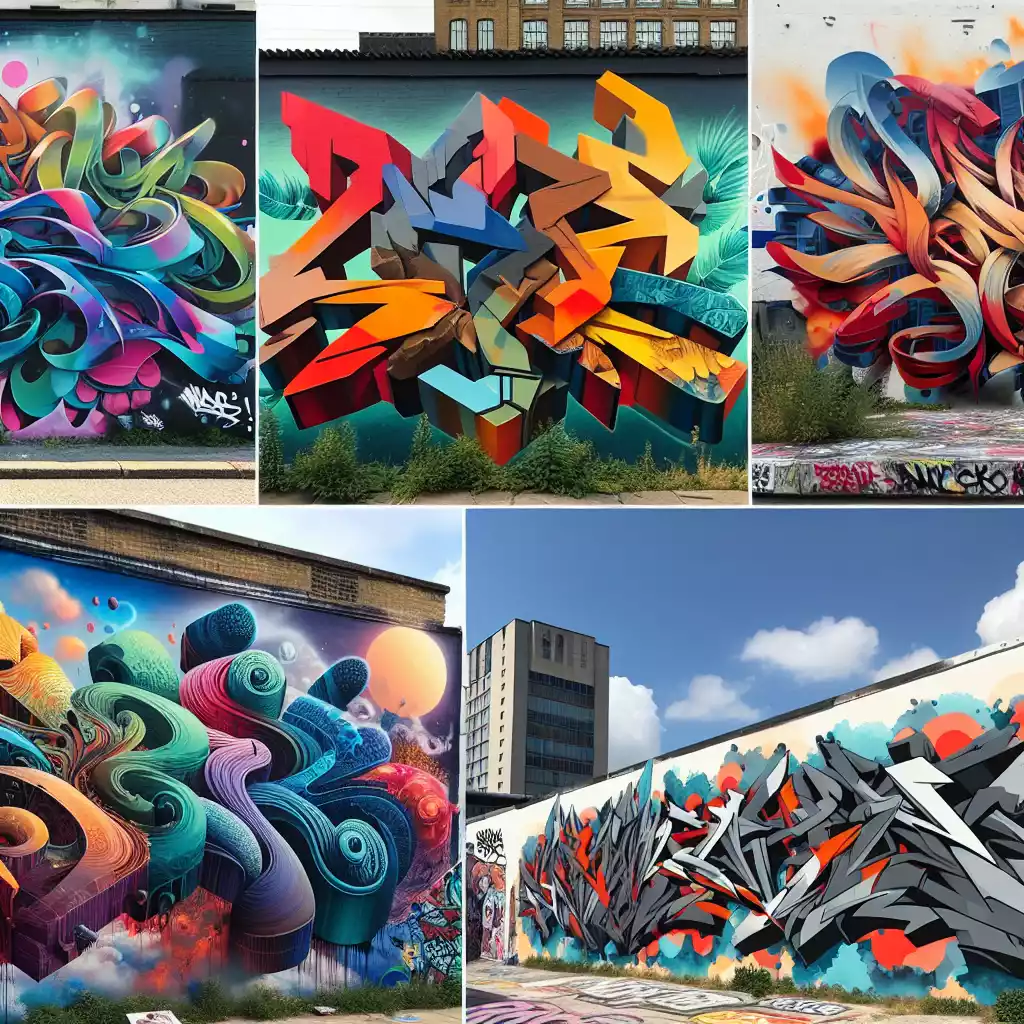Introduction to Graffiti Art
Graffiti art, a vibrant and often controversial form of expression, has captivated people for decades. From the ancient scribbles on Roman walls to the colorful murals that adorn modern cityscapes, graffiti has evolved into a powerful visual language. But what exactly makes graffiti so fascinating? Is it the rebellious spirit it embodies, or perhaps the sheer creativity it showcases? Let’s dive into the world of graffiti and explore its various forms, each with its unique flair and history.
Graffiti isn’t just random scribbles on a wall; it’s a culture, a movement that has roots in the political and social upheavals of the 20th century. The term “graffiti” itself comes from the Italian word “graffiato,” meaning scratched. This art form gained prominence in the 1960s and 1970s, particularly in New York City, where it became a symbol of urban youth culture and a medium for voicing dissent. Today, graffiti is recognized as a legitimate art form, with famous artists like Banksy and Shepard Fairey gaining international acclaim.
Understanding the different types of graffiti can provide insight into this diverse and dynamic art form. From simple tags to intricate murals, each type has its own techniques, tools, and significance. Let’s explore some of the most famous graffiti types around the world.
Tagging
Definition and Characteristics of Tagging
Tagging is the most basic form of graffiti, often considered the artist’s signature. It involves writing a pseudonym or a unique identifier using a single color, usually with a spray can or marker. Tags are quick to execute and are often found in high-traffic areas.
Famous Taggers and Their Influence
Taggers like TAKI 183 and Cornbread are legends in the graffiti world. TAKI 183’s tags across New York City in the 1970s brought widespread attention to this art form, inspiring countless others to leave their mark.
Throw-ups

Understanding Throw-ups
Throw-ups, or “throwies,” are more complex than tags but still relatively simple. They usually consist of bubble letters filled with one color and outlined in another. Throw-ups are designed to be quick and easily recognizable.
Iconic Throw-up Artists
Artists like COPE2 have made throw-ups famous. COPE2’s throw-ups are a staple in New York City’s graffiti scene, showcasing his distinctive style and technique.
Stencil Graffiti
Technique and Tools for Stencil Graffiti
Stencil graffiti involves creating a design on a stencil and then using spray paint to transfer the design onto a surface. This method allows for precise and repeatable images, making it popular for political and social messages.
Notable Stencil Graffiti Artists
Banksy is perhaps the most famous stencil graffiti artist. His works, often imbued with satirical and political commentary, have appeared in cities around the world, making him a global icon.
Wildstyle

Features of Wildstyle Graffiti
Wildstyle graffiti is highly intricate and abstract, often incorporating interlocking letters, arrows, and other elements. This style requires a high level of skill and is usually illegible to those not familiar with graffiti culture.
Pioneers of Wildstyle
Artists like Tracy 168 and Zephyr are pioneers of Wildstyle graffiti. Their complex designs have influenced generations of graffiti artists, pushing the boundaries of what graffiti can be.
Blockbuster Graffiti
Characteristics of Blockbuster Graffiti
Blockbuster graffiti features large, blocky letters designed to cover maximum space quickly. This style is often used to claim territory or make a bold statement.
Impact on Urban Landscapes
Blockbuster graffiti can transform urban landscapes, turning drab walls into eye-catching displays. Artists like RISK have used this style to create massive murals that captivate audiences.
Heaven Graffiti
Definition and Challenges of Heaven Graffiti
Heaven graffiti refers to pieces placed in hard-to-reach locations, such as rooftops or high walls. The challenge of accessing these spots adds an element of risk and excitement.
Renowned Heaven Graffiti Artists
Artists like REVOK have made a name for themselves with heaven graffiti. Their daring placements and impressive skills have earned them respect in the graffiti community.
Poster (Paste-Up) Graffiti
Methods and Materials for Poster Graffiti
Poster graffiti, also known as paste-up, involves creating artwork on paper and then pasting it onto surfaces. This method allows for detailed designs and can be quickly applied.
Influential Poster Graffiti Artists
Shepard Fairey, known for his “Obey” campaign, is a prominent poster graffiti artist. His works often carry strong political messages and have become iconic in popular culture.
Sticker Graffiti
Creation and Distribution of Sticker Graffiti
Sticker graffiti involves creating stickers with unique designs and placing them in public spaces. This form of graffiti is easy to distribute and can be highly effective for spreading messages.
Prominent Sticker Graffiti Artists
Artists like KAWS started with sticker graffiti before gaining wider recognition. Stickers can be found in cities worldwide, making them a versatile medium for artists.
3D Graffiti
Techniques for Creating 3D Graffiti
3D graffiti uses shading and perspective to create the illusion of depth, making the artwork appear three-dimensional. This style requires a strong understanding of light and shadow.
Famous 3D Graffiti Artists
DAIM is a well-known 3D graffiti artist. His works are celebrated for their technical precision and stunning visual impact.
Reverse Graffiti
Concept and Execution of Reverse Graffiti
Reverse graffiti involves cleaning dirt or grime off a surface to create an image. This eco-friendly method leaves a lasting impression without adding any materials.
Environmental Impact and Artists
Artists like Moose Curtis have popularized reverse graffiti. Their works highlight environmental issues and promote sustainability.
Yarn Bombing
Introduction to Yarn Bombing
Yarn bombing, or knit graffiti, involves covering objects in public spaces with knitted or crocheted yarn. This colorful and whimsical form of graffiti is often used to soften urban environments.
Key Figures in Yarn Bombing
Artists like Magda Sayeg have brought yarn bombing to global attention. Their installations add a touch of warmth and creativity to cityscapes.
LED Throwies
Innovation Behind LED Throwies
LED throwies are small, battery-powered lights attached to magnets, allowing them to be thrown onto metal surfaces. This modern twist on graffiti combines art with technology.
Artists and Their LED Throwies Projects
Graffiti Research Lab has been instrumental in popularizing LED throwies. Their projects illuminate urban spaces in unique and captivating ways.
Graffiti Murals
Large Scale Graffiti Murals
Graffiti murals are large, elaborate pieces that often tell a story or convey a message. These murals can transform entire buildings and are usually created with the permission of property owners.
Renowned Graffiti Muralists
Artists like Keith Haring and Diego Rivera have created iconic graffiti murals. Their works are celebrated for their artistic merit and cultural significance.
Digital Graffiti
Digital Tools and Techniques
Digital graffiti uses software and digital tools to create artwork that can be projected onto surfaces or shared online. This form of graffiti merges traditional techniques with modern technology.
Prominent Digital Graffiti Artists
Artists like INSA have embraced digital graffiti. Their works often include animations and interactive elements, pushing the boundaries of what graffiti can be.
Relevant Data on Graffiti Types
| Type of Graffiti | Characteristics | Notable Artists |
|---|---|---|
| Tagging | Simple, single-color signatures | TAKI 183, Cornbread |
| Throw-ups | Bubble letters, two colors | COPE2 |
| Stencil Graffiti | Precise, repeatable designs | Banksy |
| Wildstyle | Intricate, abstract letters | Tracy 168, Zephyr |
| Blockbuster Graffiti | Large, blocky letters | RISK |
| Heaven Graffiti | High, hard-to-reach locations | REVOK |
| Poster (Paste-Up) Graffiti | Paper designs pasted onto surfaces | Shepard Fairey |
| Sticker Graffiti | Stickers with unique designs | KAWS |
| 3D Graffiti | Illusion of depth, three-dimensional | DAIM |
| Reverse Graffiti | Cleaning dirt to create images | Moose Curtis |
| Yarn Bombing | Knitted or crocheted yarn covers | Magda Sayeg |
| LED Throwies | Battery-powered lights on magnets | Graffiti Research Lab |
| Graffiti Murals | Large, elaborate pieces | Keith Haring, Diego Rivera |
| Digital Graffiti | Software and digital tools | INSA |
FAQs
FAQ 1: What is the difference between tagging and throw-ups?
Tagging is a basic form of graffiti involving a simple, often single-color signature. Throw-ups are more complex, featuring bubble letters and multiple colors, designed to be quickly executed but more elaborate than tags.
FAQ 2: How did stencil graffiti become popular?
Stencil graffiti gained popularity due to its ability to produce precise and repeatable images quickly. Artists like Banksy used stencils to create thought-provoking and politically charged artworks, bringing widespread attention to this method.
FAQ 3: Who are the pioneers of Wildstyle graffiti?
Tracy 168 and Zephyr are considered pioneers of Wildstyle graffiti. Their intricate and abstract designs pushed the boundaries of graffiti art, influencing countless artists worldwide.
FAQ 4: What materials are commonly used in poster graffiti?
Poster graffiti, or paste-up, typically uses paper or cardboard as the base material. Artists create designs on these materials and then use wheatpaste or glue to affix them to surfaces.
FAQ 5: How does digital graffiti differ from traditional graffiti?
Digital graffiti uses software and digital tools to create artwork, which can be projected onto surfaces or shared online. Unlike traditional graffiti, it doesn’t involve physical materials like spray paint or markers, blending technology with artistic expression.
Conclusion
Exploring the different types of graffiti reveals a rich tapestry of artistic expression, each with its unique techniques and cultural significance. From the simple tags that started it all to the complex digital creations of today, graffiti continues to evolve and inspire. Its ability to convey powerful messages and transform urban landscapes makes it an enduring and impactful art form.
18 Types Of Graffiti
Ruth Aquilani is a renowned graffiti artist known for her bold, colorful, and expressive style. She began her career as a street artist in the early 2000s, quickly making a name for herself in the graffiti community with her unique and striking works of art.
